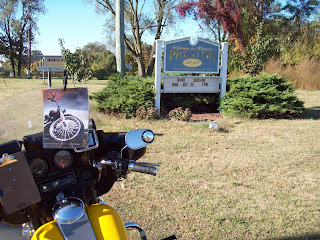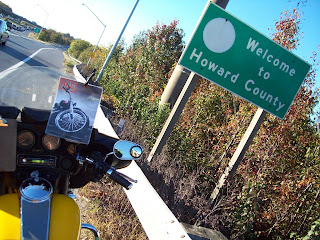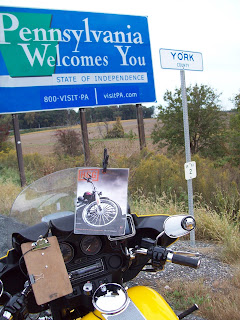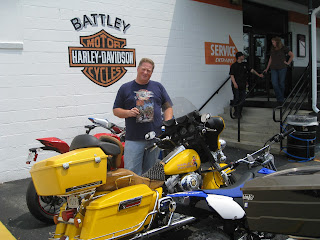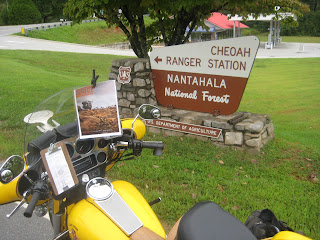How about a long ride? How about an
overnight ride with lots of long riding? It sounds great, a biker’s dream to
“get away from it all” for a few days; the quintessential road trip could be
waiting for you. Are you ready?
Now that you own a Harley and you’ve
joined the HOG chapter, you’re probably starting to go out on rides that are
longer than you’ve ever taken before. You’re probably like me when I joined; I
was used to riding socially or just commuting to work and back. All of the
sudden I’m going on these great rides, on great roads I never knew, and meeting
some great people, too. Now you’re coming home from a long ride and your body
is just exhausted and let’s face it - sore in all the wrong places. What can
you do to prevent that exhaustion and pain and leave you free to enjoy a long
ride?
Your Brain. Almost any test of your
endurance is largely mental. Even a long car ride can wear a person down
mentally; even though their body can take it, their mind cannot. Some riders
are perfectly content to have nothing but the open air rushing by their heads
and can endure a long ride with nothing but their thoughts. I’ve heard some
riders carry puzzle books – word games and such. They’ll read one or two before
getting on their bike and then try and solve the puzzle during the ride. I’m a
music fan. If you’re lucky enough to have a touring Harley, you may already
have music built in to your bike. Others use earphones or helmet speakers
connected to their cell phone. They either play music files they uploaded or stream
a music service. Since most songs are about 4 minutes long, I often play a
little game in my head and measure distances to our next stop in how many songs
will play. Music is a great way to keep the mind occupied and I recommend it.
Muscle Fatigue. You may not realize
it, but one of the reasons you feel run-down after a ride is because of the
amount of work the muscles in your arms are doing. No matter how many ways you
devise to move the other parts of your body while riding, your arms are
typically enslaved to a single riding position. The entire time they are
holding the grips, they are working against the movement of the handlebars. If
you have a batwing fairing or a windshield, this effect is exacerbated as the
wind buffets the fairing or shield and that energy gets transferred to your
arms. This is one reason why riders who regularly ride long distance highway
miles choose a fixed fairing like the Harley Road Glide. All that energy is
transferred to the frame of the bike instead of your arms. My solution (besides
dreaming of owning a Road Glide)? I try to do two things: I alter my ergonomics
(see below) and I try to relax my arms consciously. I do find that when you think about relaxing your arms, you’ll
find that they are stiff and rigid.
Ergonomics. This has to do with
moving your body and being comfortable. Think about being on a long plane ride
in one of those cramped seats where you just can’t move and how uncomfortable
that is. Many riders face the same problem on their bike. You may be perfectly
comfortable on a medium ride or running out to grab a burger, but after awhile
your body just gets sick and tired of being in the same position. The two most
important ways I combat this is with highway pegs and a driver backrest. Even
if you don’t have a touring model, Harley sells engine guards for all models
that highway pegs can then be mounted to, and they sell back rests for all
models, too. The highway pegs allow you to change your foot and leg positions.
Having floor boards instead of foot pegs helps, too, because you can move your
foot around and rest it at different angles. A foot peg can also cause a “hot
spot,” constant pressure on a point of your body that becomes increasingly
painful over time. Highway pegs allow you to put your feet up, and if
positioned correctly, you can also rest the rear of your ankles on them and
stretch your legs completely. The addition of a driver backrest allows you more
flexibility in changing positions. You can now shift up and down in your seat
and support your body with the back rest. You normally wouldn’t stretch your
legs out straight and allow your pelvis to slide forward in the seat; the
resulting arc that your back would now be in would have to be supported by you
pulling forward on the handlebars. Just not comfortable. If you want to take
baby steps, make sure you get the highway pegs first, and if you want, graduate
to a driver backrest later.
The Seat. Now we come to it. This
is the biggie, and there are a lot of opinions out there on what is best. My
friend Dave Brown has always ridden with a big, comfy Harley seat like a
Sundowner and he has gone coast to coast without a complaint. I’ve seen guys
with gel seats, air seats, and even the occasional sheepskin thrown over the
seat. Harley makes several seats for all bike models and maybe the one you’re
looking for is the one that isn’t currently on your bike. Battley has a wall of
demo seats that you can put on your bike for free and go for a ride. That way
you can feel which is best for you before you buy. After seeing so many
options, and realizing that they were all so different, I wondered if there was
a recognized “best seat for the long ride” so I wrote to the American
Motorcyclist Association. This was about 10 years ago and I wrote an article
for the Hogwash back then, complete with the letter I got back from their
riding expert (if you want a copy of that article, e-mail me at trekkiejohn@gmail.com and I’ll send it
to you). In a nutshell, the guy said that vibration is your number one enemy
and recommended a stiff seat without a lot (or any) padding with a beaded seat
on top (Battley sells beadrider seats, probably the best out there). This is
almost exactly what a cab driver in New
York would sit on for a 10 hour day. The stiff seat
doesn’t allow your “posterior” muscles to get worn out, and the beads do three
things: they let air get in between your butt and the seat, they spread the
pressure out even to avoid hot spots, and they absorb vibration. Don’t jump
into any seat changes without making an informed decision and by doing a long
distance practice ride where you actually think
about how your butt feels as you ride for longer and longer times. Take
advantage of the demo seat program at Battley, you’re not going to find a
better way of trying something out like it.
The Wind. There are two things to
consider when you think of the wind, the first is how comfortable you are
riding for two hours at highway speeds with the wind hitting you full in the
chest, and the second is a problem with hydration.
Harley makes a windshield for every one of their bikes, even if it isn’t a
touring model, so if you go out on the highway and can’t handle that wind
beating you down, invest in a windshield. Many models allow for a removable
windshield, so if you’re not on a long trip, take it off and leave it in your
garage. The wind also dries things out, like your skin. People can get wind
burn, and you get dehydrated faster as the wind passes over your exposed skin.
Just like leaving a t-shirt out in the breeze to get it to dry faster, so will
your skin. Even on a nice day, try to wear a long sleeved shirt, bring
moisturizer for your exposed areas, and yes, sun screen helps prevent windburn.
The most important thing to remember is to drink water. Just sitting in the
saddle for two hours without drinking is bad enough, but add the sun and the
wind and you can quickly become dehydrated. The best thing to do is figure out
a way that you can take sips of water while riding – most people get some sort
of holder for a water bottle, but at the minimum remember to drink plenty of
water at each stop.
Lastly, just when you thought we
were done – Clothing. The choice of what you wear on a long trip makes a huge
difference, especially – you guessed it – your underwear. The general rule to
live by is to avoid cotton at all costs. Cotton retains moisture which leads to
rashes and the dreaded “monkey butt.” But cotton can also easily bunch up, and
every fold is a place where your weight isn’t evenly distributed, which means
hot spots. The best choice is some sort of athletic, moisture wicking sports
material, like Under Armor. My favorites are buck naked boxers from www.duluthtrading.com but most of the
big sport companies make them. Although we Harley riders love to wear our
jeans, think about alternate materials for pants, too. If you get caught in a
sudden downpour, jeans can stay wet for hours. Of course, the smartest riders
wear protective pants and jackets with embedded armor in case you wreck.
Battley sells many varieties and you’d be surprised at how well they breathe
and keep you cool even though they look heavy and hot. The last word on
clothing – pack light for your trip. The moisture wicking clothing usually has
the advantage that you can wash it in your hotel sink and it will be dry by
morning. Don’t over pack your bike or you won’t have room for that souvenir
t-shirt.
Well, there you have it: John’s opus on long distance
riding. If it is too much to take in, here is the abbreviated crash course: In
my opinion to enjoy many hours in the saddle, get yourself some music, a
windshield, highway pegs, the right seat, and good underwear. I sure hope that
helps you take on longer rides and enjoy them

